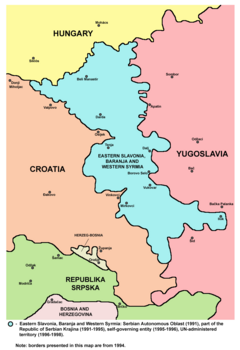
Back اتفاقية اردوت Arabic Erdutski sporazum BS Acord d'Erdut Catalan Abkommen von Erdut German Convenio de Erdut Spanish Accord d'Erdut French Erdutski sporazum Croatian Erdődi megállapodás Hungarian Accordo di Erdut Italian 에르두트 협정 Korean
| Basic Agreement on the Region of Eastern Slavonia, Baranja and Western Sirmium | |
|---|---|
 | |
| Type | Peace agreement |
| Signed | 12 November 1995[1] |
| Location | Erdut, Croatia |
| Signatories |
|
| Parties | |
| Full text | |

| History of Slavonia |
|---|
 |
The Erdut Agreement (Serbo-Croatian: Erdutski sporazum / Ердутски споразум), officially the Basic Agreement on the Region of Eastern Slavonia, Baranja and Western Sirmium, is an agreement reached on 12 November 1995 between the authorities of the Republic of Croatia and the local Serb authorities of the Eastern Slavonia, Baranja and Western Syrmia region on the peaceful resolution to the Croatian War of Independence in eastern Croatia. It effectively ended the ethno-nationalist conflict in the region and initiated the process of peaceful reintegration of the region to central government control. The reintegration was directly implemented by the United Nations. The agreement provided a set of guarantees on human and minority rights as well as on the refugee return. It was named after Erdut, the village in which it was signed by local Serb representatives.
The signers were Hrvoje Šarinić, the former prime minister of Croatia, and Milan Milanović, a local Serb politician representing the self-proclaimed Republic of Serbian Krajina (RSK) under instructions from the authorities of the Federal Republic of Yugoslavia. The witnesses were Peter Galbraith, the ambassador of the United States to Croatia at the time, and Thorvald Stoltenberg, the United Nations intermediary.[4]
The territory of Eastern Slavonia, Baranja and Western Sirmium had previously been controlled by the RSK, and before that by the SAO Eastern Slavonia, Baranja and Western Syrmia. The agreement was acknowledged by the United Nations Security Council Resolution 1023, and it paved the way to the establishment of the United Nations Transitional Authority for Eastern Slavonia, Baranja and Western Sirmium. Contrary to most of the other missions, UNTAES was modelled as the supreme governing authority in the region creating one of only a couple of United Nations protectorates in the history. While ensuring full reintegration of the region without territorial autonomy clauses, the agreement served as a cornerstone for the establishment of contemporary Serb minority institutions not only in the region but the rest of Croatia as well. It explicitly provided the basis for the establishment of the regional Serb institution of the Joint Council of Municipalities.
- ^ Galbraith, Peter (12 October 2006). "Negotiating Peace in Croatia: a personal account of the road to Erdut". In Blitz, Brad K. (ed.). War and Change in the Balkans. Cambridge University Press. pp. 124–131. ISBN 0-521-86042-3.
- ^ Agreement has four signatures: Šarinić, Milanović, Galbraith, and Stoltenberg
- ^ "Former U.S. Ambassadors to Croatia - Embassy of the United States". Zagreb, Croatia. 28 June 1993. Archived from the original on 17 June 2016. Retrieved 1 June 2016.
- ^ Lukic, Renéo (2006). La politique étrangère de la Croatie, de son indépendance à nos jours, 1991-2006. Les Presses de l'Université Laval. p. 193. ISBN 2763780199.
© MMXXIII Rich X Search. We shall prevail. All rights reserved. Rich X Search